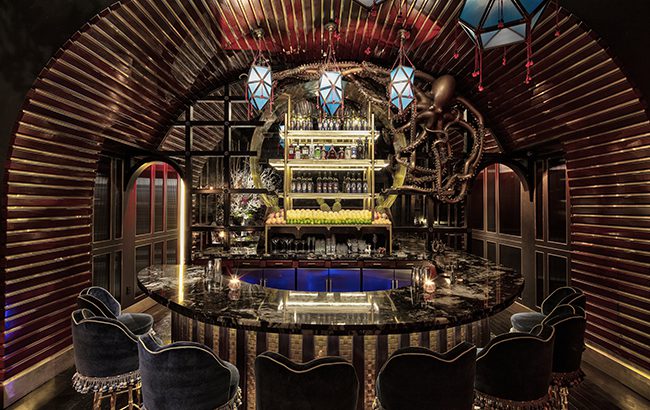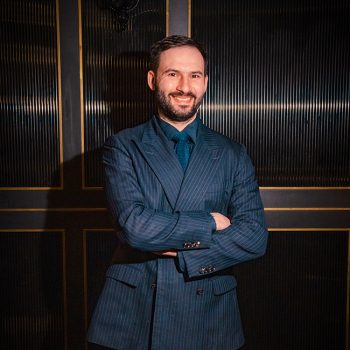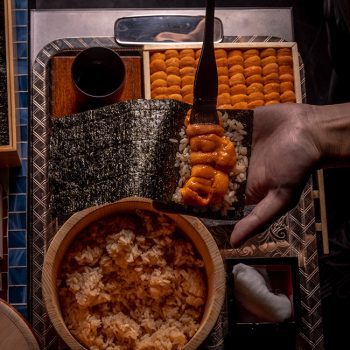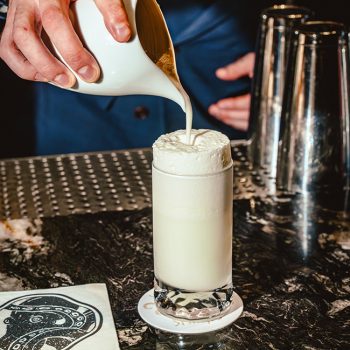Shinji’s Jonathan Adler on achieving the impossible
By Lauren BowesAmong many other feats of cocktail mastery, New York’s Shinji’s bar can shake up a Ramos Gin Fizz in just five seconds.

*This feature was originally published in the September issue of The Spirits Business magazine.
Given the name, the sushi restaurant next door, and the 200-plus Japanese whiskies lining the shelves, you might assume Shinji’s is a Japanese-style cocktail bar. But you would be wrong.

“Japanese-style bartending is a very specific thing,” says Jonathan Adler, beverage director of the bar, which is in the Flatiron District of Manhattan, New York. “If you go to Ginza [in Japan], it’s usually a bar with no menu, where it’s a conversation between you and the bartender. They’re building the drink to order with no batching whatsoever. That’s very far from what we do.”
Shinji’s is almost the opposite, using modern culinary techniques and precise batching. Japanese ingredients often appear in the cocktails, but not for the sake of a theme. “We use Japanese ingredients – but not for any other reason than a lot of my background comes from working with Japanese cuisine,” he says. “These are ingredients and flavour profiles that I generally enjoy.”
Those ingredients and flavour profiles extend to the food, with Shinji’s sharing a kitchen with Michelin-starred sushi restaurant Noda. “If it wasn’t for Shinji, Noda wouldn’t exist, and if it wasn’t for Noda, Shinji’s wouldn’t exist,” Adler says, referring to the two ventures’ namesakes.
Former food journalist Shinji Nohara rose to fame after appearing on Anthony Bourdain’s TV show A Cook’s Tour. He helped him discover some of Japan’s best restaurants, which at the time – and even now – were hard for foreigners to discover. After the programme took off, other chefs asked Bourdain whether Shinji could do the same for them – and he often did. He became known as “the Tokyo fixer”, getting people into venues for a daily rate and expenses.
When the owners of Noda were developing their sushi restaurant, Nohara introduced them to chef Shigeyuki Tsunoda. “When we were looking to name the bar concept, we thought there was no better person to name it after than Shinji,” says Adler.
The service style at Shinji’s mirrors that at Noda – “definitely fine dining, but not too buttoned up”, according to Adler. Both venues have eight seats around their respective counter or bar, though Shinji’s benefits from an additional three banquettes.

The drinks are rooted in modern culinary techniques, with the bar’s Ramos Gin Fizz taking only five seconds of shaking, while the Hot Cold Toddy offers two temperatures in one serve. “A lot of times it’s thinking of something that would be impossible, then figuring out how to make that happen,” says Adler. “Believe it or not, the most difficult part is coming up with an original thought of something impossible.”
But for him, the drinks aren’t the main draw. “The cocktails bring people to the door, but where we really shine is our service and hospitality,” he says. “There are a lot of bars with modern techniques where the spiels can be a little overbearing.”
Dazzle the guests
Ultimately, the aim is to dazzle guests without telling them why they should be impressed. “We have so many regulars who come time after time, and I don’t think I’ve told them once about all the days and hours of work that go into the drink service,” says Adler. “Hospitality is kind of like a knife fight,” he muses. “You want to spend as little time in battle as possible. You want to spend a lot of time reading the other person’s movements and only go in when you’re ready. It’s the same thing with hospitality – you need to listen 100 times more than you speak.”
Although Shinji’s recently ranked 90th on North America’s extended 50 Best Bars list, Adler says he isn’t chasing accolades. “It’s amazing to be recognised for these things, mainly because of the business it brings in – but that can never be the goal,” he says. “Our goal is to continue doing what we’re doing to the best of our ability, and to keep giving people amazing experiences.”
Shinji’s Gin Fizz

“It’s important to understand the way a normal Ramos Gin Fizz would work to understand how ours is sped up,” Adler explains. The serve stays faithful to the classic – gin, citrus, sugar, egg white, cream – with only the method changing.
The volume in a traditional Ramos comes from shaking air into the proteins and fats in the egg white and cream. At Shinji’s, that air is already stored inside freeze-dried egg-white powder, whose albumen has been whipped and dehydrated so it traps air readily.
Instead of orange blossom water, Adler brews a marigold tea that mimics the flavour but, crucially, lets him control the exact dilution, replacing both the water lost from using dried egg white and what you’d normally get from shaking with ice. That tea, the egg white, and a vanilla-hojicha syrup are then batched and kept in the fridge.
The cream is charged in a whipping siphon, dispensed with liquid nitrogen to create frozen aerated cream, then blitzed and portioned before storing in the freezer.
When it’s time for service, the egg-water-syrup mixture and the frozen cream are combined with freshly squeezed citrus juice and given a “a very soft, five-second shake” – just enough to combine the proteins and fats from the cream and the egg white. The mixture is poured into pre-measured soda water and the head forms instantly. “You could even stir it,” Adler adds. “It just takes a little longer to bring everything together.”
Related news
Cocktail chat: Foco, Barcelona
